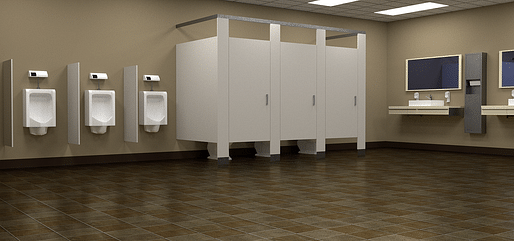

The COVID-19 pandemic has necessarily prompted a rethinking of many of the most fundamental aspects of daily life around the world, as people, businesses, and governments seek to retrofit the built environment in order to minimize the potential for future exposure.
Everything from HVAC systems, office spaces, grocery stores, shopping areas, and universities will need to be rethought, experts argue, with wide-ranging and yet-to-be-known changes in store for how we live our everyday lives.
Another arena that is due to be seriously reconsidered is that of the public bathroom, where open toilet stalls and open-top toilets are known to generate unhygienic "toilet plumes" that aerosolize fecal matter and potentially, diseases within these spaces.
A recent Fast Company report delves into the approaches that some bathroom fixture manufacturers are taking while retooling their designs in response to the pandemic. As can be imagined, many of these approaches lean toward "touch-free" and "contactless" configurations for individual fixtures, but a more fundamental shift is also potentially underway: Single-stall toilets.
Over the last few years, universities, government buildings, and increasingly, commercial facilities have begun to embrace single-stall toilets due to lobbying from transgender and disability rights groups. These changes, slow to get off the ground but increasingly widespread, could take on new life as these same entities seek to limit the spread of disease within their facilities.
Additionally, as the nationwide homelessness epidemic has intensified in recent years, cities around the country have begun to prototype new approaches of their own for public restroom designs. SmithGroup, for example, recently piloted a new self-cleaning bathroom pod in San Francisco. New York City is taking a similar, though less generous approach by deploying new, but smaller public bathroom designs. Meanwhile, countries around the world, like Japan, have strong public bathroom infrastructures already in place.
For architects, the growing need to seriously reconsider bathroom designs from a variety of perspectives, including accessibility, gender preference, lactation, and now virus control, offers a potential site to explore and assert design toward useful and just ends. Are clients and municipalities up to the task of reconsidering these spaces? With COVID-19, they just might have to be.
1 Comment
I don’t disagree with the suggestion. However replacing group restrooms with single-occupant restrooms creates new issues. The more barriers we create for humans to be hygienic, the less likely they will use facilities well. And on top of that, if there are more barriers for custodial staff to complete their work, then less likely they are to effectively sanitize the space. The positive aspect of current typical American group restrooms is the openness, which allows custodians to efficiently and effectively sanatize the restroom, and more efficient mechanical systems. Part of the value of group restrooms is the social stigma that comes with not washing your hands and possibly being scolded by other people. In single-occupant, people could totally not wash properly, and not fear being socially scolded.
I think increasing availability of facilities could be a good move (more fixture requirements). Or requiring hand washing stations upon entry to all buildings. Or possibly automated sanitizing toilets would be a worth-while innovation.
#rickitect
Block this user
Are you sure you want to block this user and hide all related comments throughout the site?
Archinect
This is your first comment on Archinect. Your comment will be visible once approved.